Edit: I’ve filmed an extensive video tutorial on this process, find it here on my blog.
While posting pix of my quilt in progress on Instagram , I had a question about my quilt as you go method. So while continuing with the quilting, I shot some quick pix with my phone and Instagrammed a quick tutorial. Although the pictures aren’t brilliant, I thought I’d share this on my blog, in hopes that this would help folks overwhelmed by the thought of pushing a whole quilt through that space to the right of the needle!
This quilt that I’m calling “Modulating Squares” starts with columns of squares sewn together. In this case, the reverse side of the quilt is another set of squares, read more about the design here. Whether you have a second set of blocks or a single strip of fabric, I layer the top and back with batting in between and quilt that first column. I am using “Fusi-boo” bamboo fusible batting, so I am basting with my iron. You can also baste with pins or (horrors!) some hand stitching. I quilt this whole column, making sure to quilt all the way to the edge of the left side, this is an outside edge of the quilt, but I leave and undulating space of ~ 0.5-3″ of unquilted space on the right-hand side. I am going to add the next column there, and will fill in those blank spaces when I quilt the next column. This will help blend the overall quilting pattern, helping it not look so strippy.
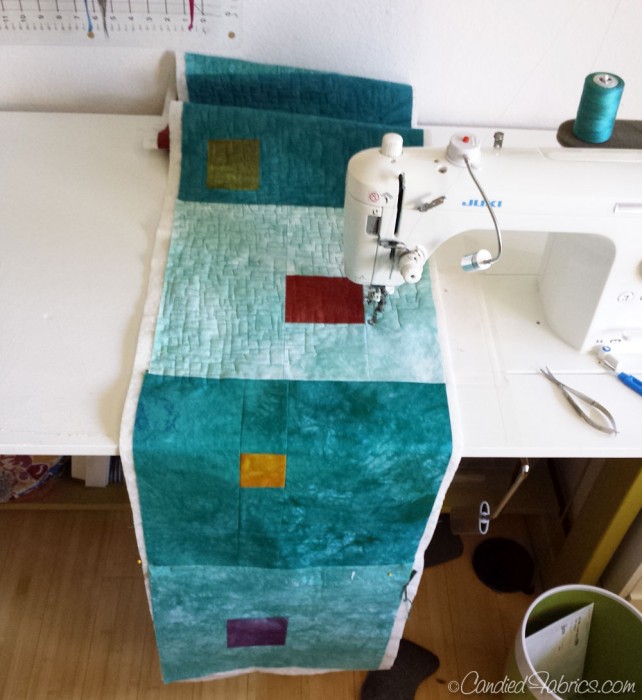
Here I’ve added that second column. The quilted column is now out to the left, the new column goes under the arm. Also note that the right edge of the unquilteded column has batting sticking out. This gets trimmed after the quilting of this column.
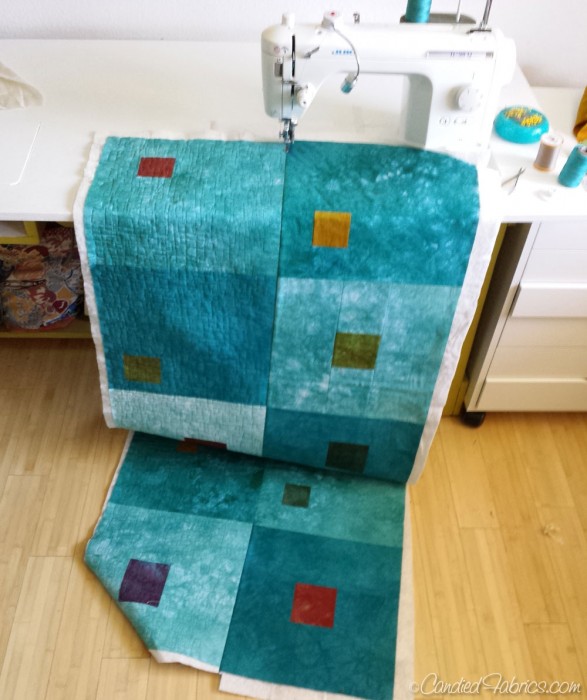
You can see that I’ve filled in the quilting between the 2 columns on the top half, but down below you can see some of that un-quilted margin that is yet to be covered up.
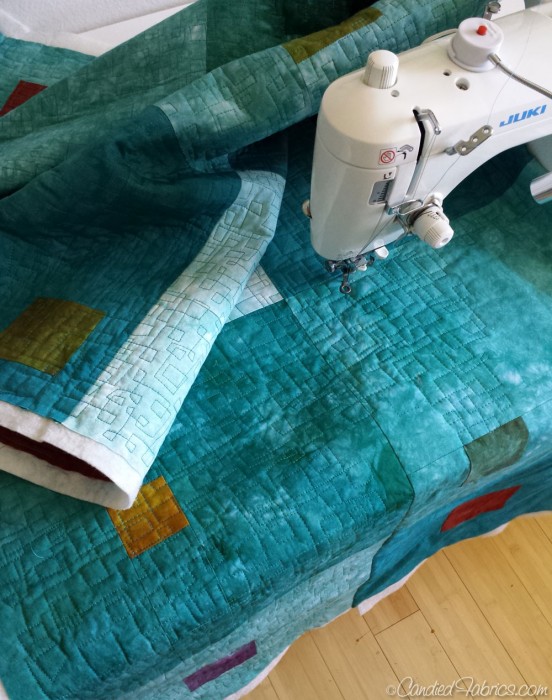
Once the column is quilted, press it well and trim the excess batting from the edge you’re going to add the next column to. Then place the next column on top of the quilt top right sides together, and the next backing column on the quilt back, right sides together and pin.
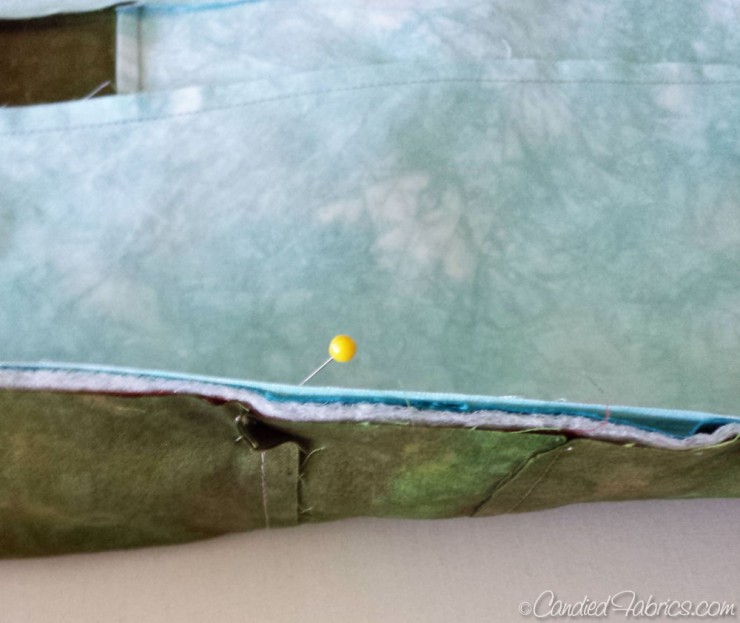
Here I’ve folded back the quilt top while pinning, and also tried to show that the quilt backing is underneath there as well:
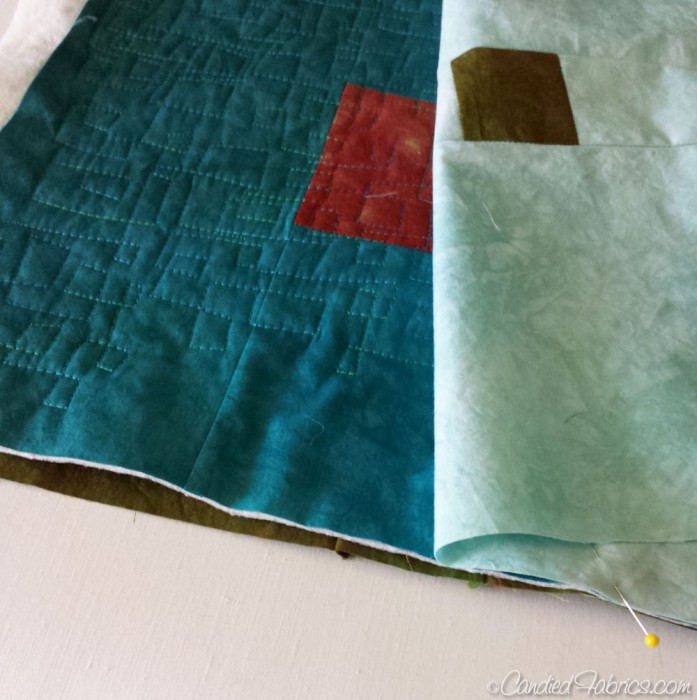
Once that new front and back are pinned on, stitch them onto the quilted part, a walking food if very helpful here:
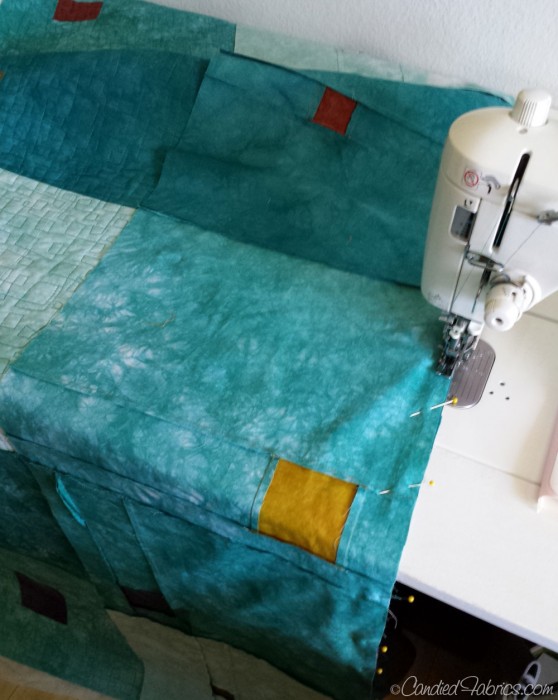
Then you slide the new strip of batting in (you’ll need a nice straight edge on it, butting it up to the the seam):
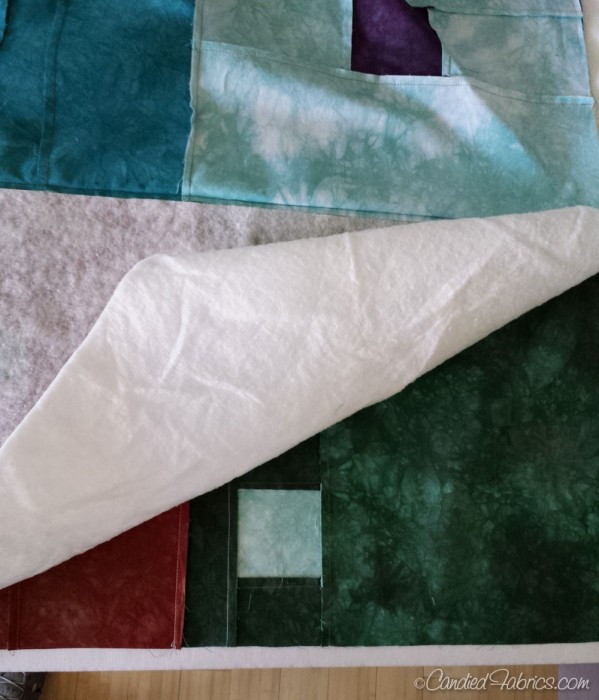
Hopefully you can see how to butt the batting up against the batting in the seam here:
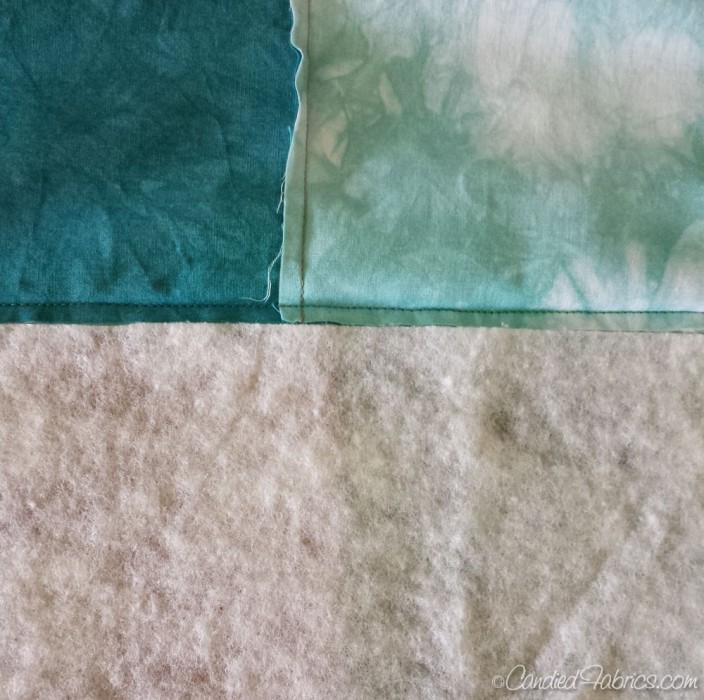
Then you flip top over and fuse to baste! (Or baste another way, but still be sure to press first).
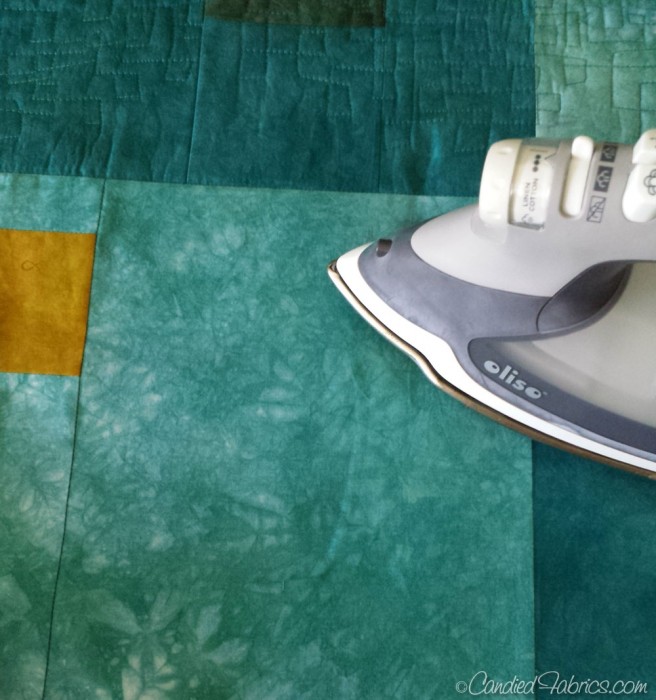
And now you’re ready to quilt another row! See how all the quilted columns are off to the left?
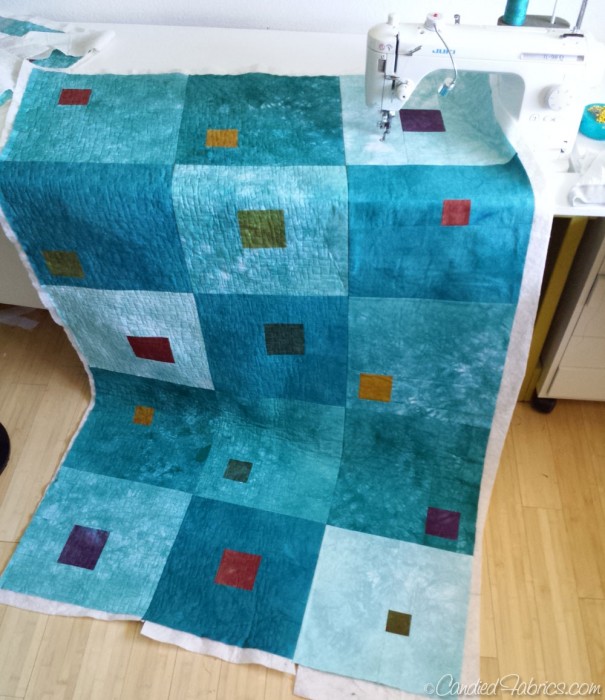
Here’s a peek at the back:
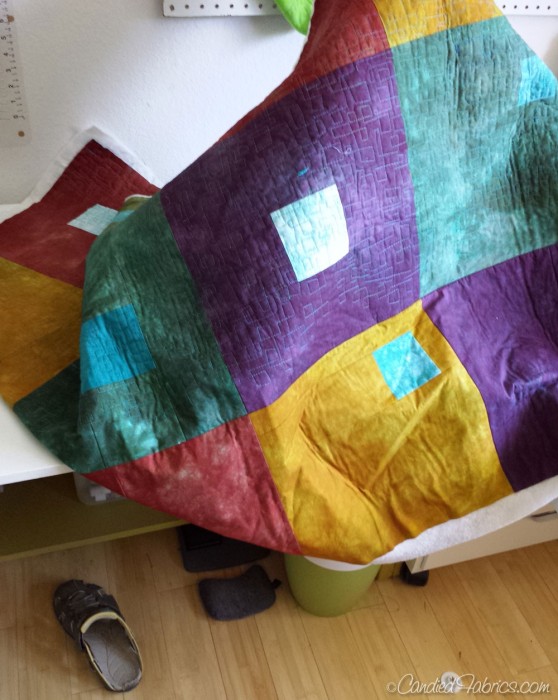
Here I’ve added the final column:
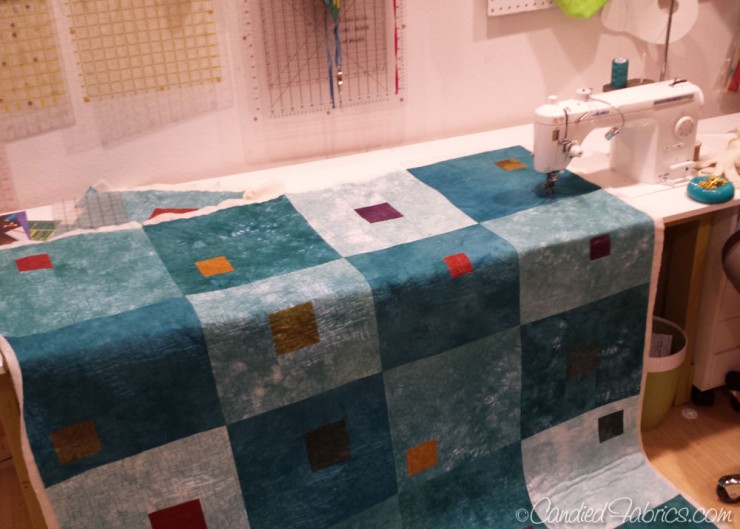
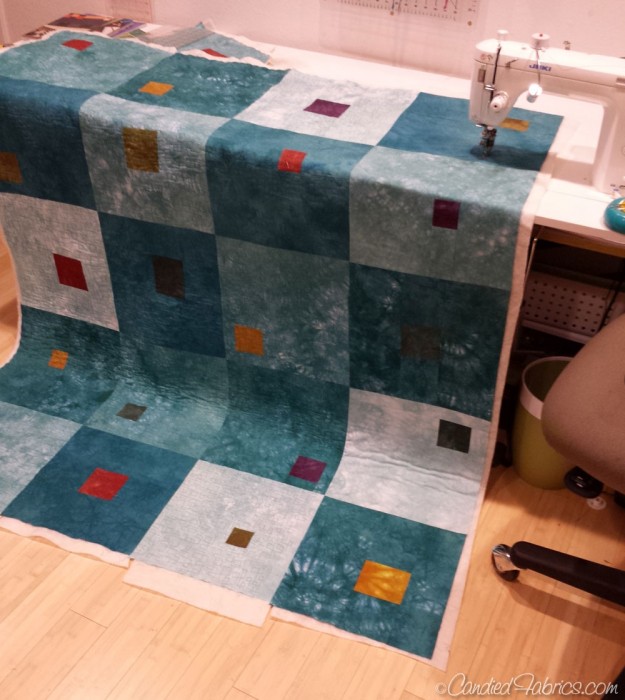
OK, I hope this was helpful! I’ve finished the quilt and I think it’s FABULOUS! I’ll share tons of pix tomorrow, but here’s a sneak peek:
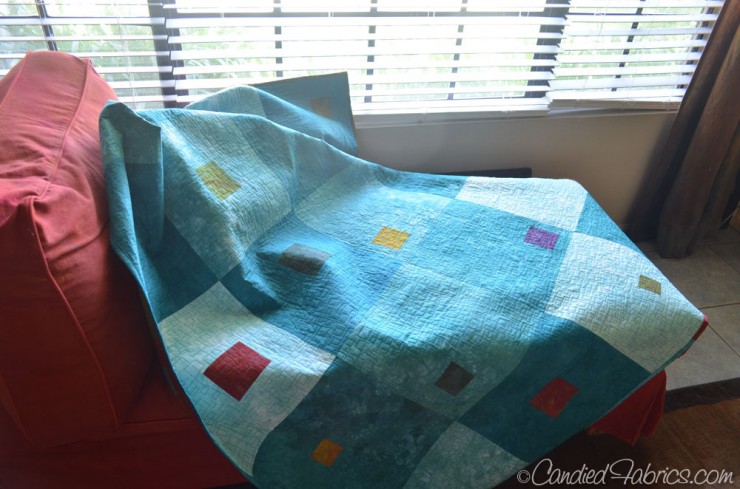

44 Responses
Candy. The saying goes ‘ a picture is worth a thousand words’… Thank you so much. I have read and seen many descriptions re quilt as you go. This one has absolutely nailed it for me. Regards Sue
I am SO happy this could help Sue! Go forth and quilt! 🙂
Great tutorial, thanks Candy! And such a beautiful quilt!
Great tips there, thank you!
Oh this is a fantastic method–and all the bulk is off to the left, too! I love this modern quilt…just beautiful colors…Julierose
Thank you , thank you, thank you. I am just now getting started on my projects for the upcoming season and was looking over all kinds of QAYG. None of them were as remarkable as this one is. I love the fact that there is no sashing anywhere. YAHOO!!! Thanks a millon.
You are a genius! I put mine together this way and spent the evening trying to tell others on a couple of forums how to do it; was totally unsuccessful at articulating. In a last ditch effort to find something to explain I googled AGAIN and this time my search words combination led me here. THANK YOU!!!!!!
Once I started to see how people were putting qayg together with sashes I was pained for all those doing it. It is so much wasted time and a design loses it fluidity with the sashes (well, in my opinion). As a dressmaker I just put together as seemed “right” for my sewing background and was surprised no body seemed to be doing it this to-the-pint and efficient way. You have done a wonderful service to quilters all over for this tutorial.
Linked your site at Missouri Star Quilt Forum and Quilting Board Forum.
Hi Candy,
I love your technic, I am a beginner and was wondering if you will do your technic on video some day.
I found your site from the link on the Quilting Board. Your pictures are wonderful. This make makes Quilt As You Go “doable!”
Thank you so much!
This is much better than other ways and the first time I have seen it done like this. Great idea.
I just saw this link on the Quiltingboard. I too have tried QAYG with sashing, but did not like it. I love this method. I am bookmarking your site. I have several quilts needing to be finished, I can’t wait to try this method.
What happens to the seams where there is no batting ‘in’ the seam (ie where two batting columns meet but are not joined)? Doesn’t it feel ‘thin’ or too ‘mobile’ along those lines?
THere is batting in the seam…you actually have the batting larger than the top and bottom while quilting, and then trim it even just before adding the next column. I’m planning on making a video on this technique in December, so I will be sure to show this part in the video!
It took me a couple of readings to totally grasp what you are doing and I have got to say, it is wonderful! I have always struggled with what to do with the backing fabric in order to make it seem seamless. I love what you did with yours and the finished product is so nice! Thanks for sharing!
Love, love this first time I’ve seen this.
I QAYG all my large quilts. I believe I’ve tried every method on earth but I’m intrigued with your method. I’ve also done several quilts with the “quilting in sections” method. I wasn’t able to continue doing them that way because of the arthritis in my hands and I’m not able to cut out all that batting in the seams before joining the sections and sewing on the covering strip. When you butt the battings do you attach it any way but the basting? could I zigzag with a wide stitch to attach the two battings? Love, love love this!
Can’t wait to get started. Having a problem visualizing how the backing get seamed. Hopefully when I test a couple blocks, the light will come on for me. Just recewived my walking foot and first need to see how to operate it.
You have convinced me to try a quilt-as-you-go quilt. I have never liked the idea of using sashing. Thanks so much for another way to quilt. Looking forward to your video!
REALLY looking forward to your video tutorial on the sashless QAYG technique!
I guess I’m a little slow here. I’m looking forward to a video. I can understand parts, but not the joining part.
I’m with you on that! I just don’t get how there is not a “raw edge” seam that joins them. Does it overlap or tongue & groove connect?
When you join the second row the original raw edge is sandwiched between the front and backing of the second row(including the batting). The batting is then trimmed before bringing the new section of backing to the right. Press as you would any seam. The next piece of batting must have straight edge to butt up to the edge of the first strip and be wide enough to leave a bit of excess for ‘take-up’ during quilting. Then the front is brought to the right over the batting. You now have another section of quilt to fuse or baste. Once basted the quilting is done as in the first section, again leaving a random gap at the right edge to link the quilting pattern across the seam to make it cohesive across the entire quilt. Hope that helps. Candy found this tutorial has changed my ideas on QAG thank you.
This is a great method for QAYG Thank you so much.
Brilliant! I do like the option of no sashing. Thanks so much for sharing this.
where will you post the video i love to see it i have always wanted to make a quilt
Here it is:
https://www.candiedfabrics.com/2014/01/15/video-tutorial-quilt-as-go-no-sashing/
thank for the video but i have not been a round a sewing machine over 40 yrs as far as sewing i use to make sun dress for my self wow i had to have been 18 at that time but i looking for a step by step video do you have one of those some of those terms you talk about i no nothing about i really want to try i have search you tube and cant find anything
Thank you kindly. This is brilliant and I do believe will greatly help me along with my ufo’s. I can see that this method of adding the batting will work well even with whole quilt tops.
Cheers
Shari in Australia
Very cool, I can see uses for this in my art quilts too, i sometimes do them in sections, thanks!
Thank you so much for the effort you made with the videos and these photos to teach your method. Since I love doing everything by machine, this method is the one I believe I will use going forward. I think quilting over the column-join makes that join simply disappear. I really enjoy it. Thanks again!
This is the best QAYG tutorial so far. I’ve only ever stuck to runners and toppers becasue I couldn’t stand the thought of quilting anything larger but with this tutorial I’m willing to give it a try. Thanks so much.
This is a wonderful method and a wonderful tutorial. Thank you.
Loved the QAYG tutorial. I’m always looking for a way to make life easier. Thank you.
You Are A Goddess. A temple should be built in your honour & I at least will come & make offerings of thread balls from making a real Quilt As You Go quilt. I’ve known about this method (which to me is the only one that makes sense) but haven’t been able to find any information. And along comes you. Well done you.
Well, I am glad I could help! 🙂 I look forward to my temple, LOL!!!!!!!!!!!!
Wow absolutely love this quilt and the colors. Do you quilt it on your sewing machine and does this mean you have a special machine? I would love to make one like it. Summer colors. Just gorgeous. Thank you for sharing. Now I just have to have more information. Regard Trudy
Candy, I watched many videos looking for a way to join my pieced blocks in a way that I could quilt them as I joined them in the easiest way possible. You can’t imagine how delighted I was when I finally came across your u-tube video. It is exactly what I was looking for. I was disappointed I could not find any more videos, but was equally delighted when I came across your blog with the pictures and explanation. You can be sure that I will be joining my blocks to rows, quilting them, and joining my other rows as you have shown here. And, I can’t wait to get started! Thank you for taking time to do this for us who are looking for a way to machine quilt using our sewing machines.
Alice Cornelson
This is very clear and cleverly done, finally I am keen to try quilt as you go!
I can’t wait to try this! What a great method! Thank you!!
I have made a few quilts this way and found it easy-just a lot of pinning. It follows Kaye Woods method of the 6 hr quilt. Also When adding the last backing piece I make the backing about 2in bigger on the outside as when I turn the last piece over I have a self binding. It sure makes quilting a larger quilt easier.
I think I could do this!!!!!! Been looking for a way to do it without adding extra strips in between or hand sewing. Thanks!
Candy,
I’m a new quilter (and a very nervous one at that, for fear of mistakes), and have only made one small baby quilt. It took me so long that now the child uses it for her dolls. lol I am now going to attempt a full size quilt for my granddaughter, with a soccer theme (hopefully I will finish it before she goes to college, she’s 13).
Here’s my question, on the final column … Should I quilt all the way to the edge on both sides, being there are no more rows to add?
I’m going to try your method, but have one more question. I was going to use one of her flat sheets for the backing. By using your idea, I will have to cut the sheet into squares then … right? I really didn’t want to do that, but I know with all the bulk of such a large quilt, it would be easier to do it your way.
Please let me know how I should handle this. If you (or anyone else) have any other pointers, please feel free to educate me. I could use all the help I can get.
Thank you!
Susanne